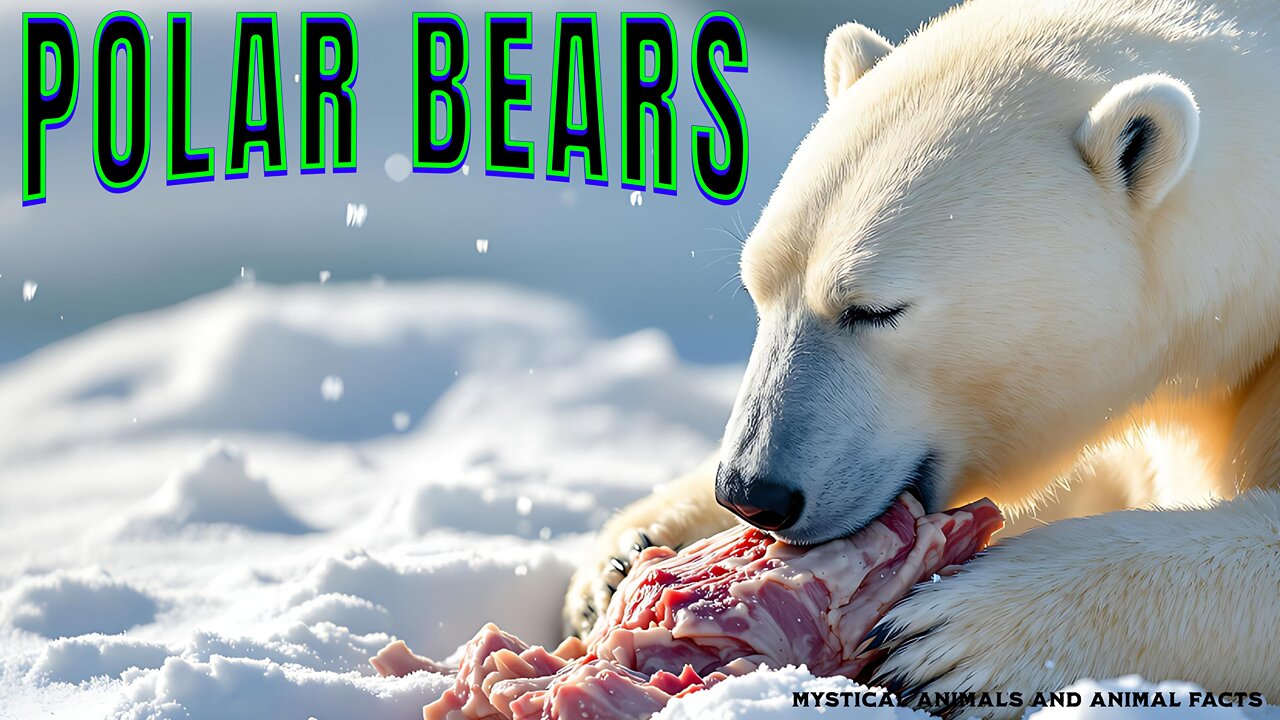Premium Only Content

Polar bears: beautiful hunters from the Arctic - mini documentary
Shirts and more
Designs Redbubble
https://www.redbubble.com/people/ReneMM/shop?asc=u
Spreadshirt.at
https://www.spreadshirt.at/shop/user/renemm/?srEdit=pa#?affiliateId=1257693
Spreadshirt.com
https://www.spreadshirt.com/shop/user/renemm/?srEdit=pa#?affiliateId=11625
Shirtee.at
https://www.shirtee.com/de/catalogsearch/result/index/designer_id/112048/all_stores/
1/
Polar bears, scientifically, are the largest land-living carnivores on earth and are found exclusively in the Arctic. Their habitat extends across the pack ice and coastal regions of the northern polar region, including parts of Canada, Greenland, Norway, Russia and Alaska. As highly specialised hunters, they are closely adapted to life in extremely cold and ice-covered environments. Adult males reach a body length of up to 3 metres and a weight of 450 to 600 kilograms, while females are significantly smaller and usually weigh between 150 and 250 kilograms. The polar bear's characteristic white fur consists of hollow, light-refracting hairs, which not only provide insulation but also serve as camouflage in snow and ice environments. Beneath the dense fur is a layer of fat up to 10 centimetres thick, which provides additional protection from the cold and serves as an energy reserve, especially in times of low food availability. Polar bears are excellent swimmers, able to cover distances of over 60 kilometres without stopping thanks to their strong front legs and partially webbed paws. Their main food source is ringed seals, whose breathing holes in the ice they detect with exceptional patience and a highly sensitive sense of smell that can detect prey even under metres of snow or from a distance of over a kilometre. The hunting strategy of polar bears is based on the element of surprise: they lie in wait at breathing holes in the ice or slowly dig their way towards approaching seals in order to kill them with a targeted bite to the skull. In addition to seals, they also occasionally prey on young walruses or stranded whales and eat bird eggs, algae or carrion when food is scarce. The reproduction of polar bears is closely linked to the seasonal conditions of the Arctic. In late autumn, females retreat into snow caves they have dug themselves, where they usually give birth to one or two cubs during a hibernation period of around two months. The newborns are only 30 centimetres tall at birth and weigh around 500 grams, but are raised quickly thanks to their mother's nutrient-rich milk. The family does not leave the den until spring, when the cubs are robust enough to withstand the Arctic temperatures. Young polar bears stay with their mother for up to two and a half years to learn hunting techniques and survival strategies before starting an independent life. Very interesting predators that live in icy regions, what do you think of polar bears. I would be very happy about a like and a subscription.
-
 1:26:04
1:26:04
Glenn Greenwald
5 hours agoJournalist Ken Klippenstein on Trump's New Domestic Terrorism Memo; Glenn Takes Your Questions on Bari Weiss's CBS Role, His Interview with Nick Fuentes, and More | SYSTEM UPDATE #526
57.2K37 -
 LIVE
LIVE
SpartakusLIVE
4 hours ago#1 All-American HERO with LUSCIOUS hair and AVERAGE forehead brings Friday Night HYPE
364 watching -
 LIVE
LIVE
SynthTrax & DJ Cheezus Livestreams
2 days agoFriday Night Synthwave 80s 90s Electronica and more DJ MIX Livestream GOTH NIGHT Special Edition
141 watching -
 LIVE
LIVE
Mally_Mouse
5 days agoFriend Friday!! 🎉 - Let's Play! - Lockdown Protocol
226 watching -
 LIVE
LIVE
MissesMaam
2 hours ago*Spicy* Friend Friday LOCKDOWN Protocol!!! :: SpookTober 💚✨
79 watching -
 41:36
41:36
MattMorseTV
3 hours ago $7.29 earned🔴Portland just made a BIG MISTAKE.🔴
20.6K53 -
 LIVE
LIVE
LFA TV
1 day agoLIVE & BREAKING NEWS! | FRIDAY 10/3/25
459 watching -
 4:07:27
4:07:27
Nerdrotic
7 hours ago $7.71 earnedHollywood is TARIFFied, James Gunn Attacks Fans, Bill Burqa, RoP is Doomed | Friday Night Tights 374
63K8 -
 LIVE
LIVE
Eternal_Spartan
11 hours ago🟢 Eternal Spartan Plays Destiny 2 | The Best PVP/PVE Action!| USMC Veteran
36 watching -
 LIVE
LIVE
Jorba4
2 hours ago🔴Live-Jorba4- Borderlands 4
13 watching
